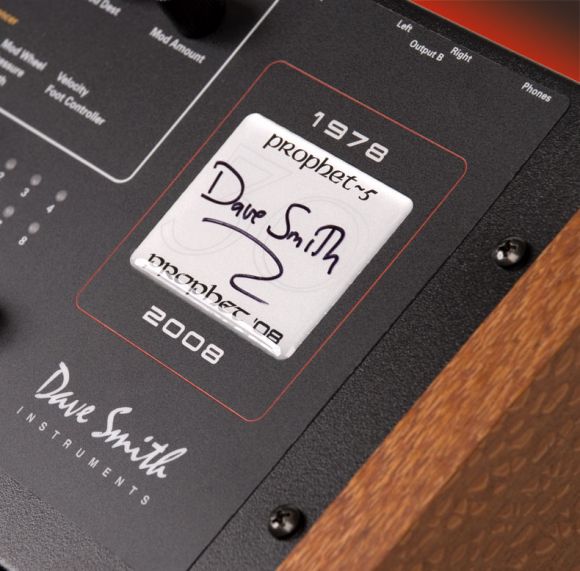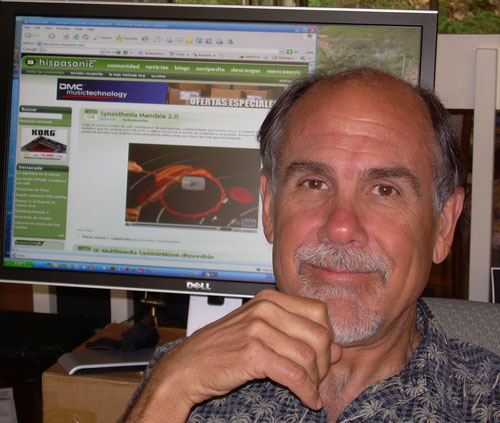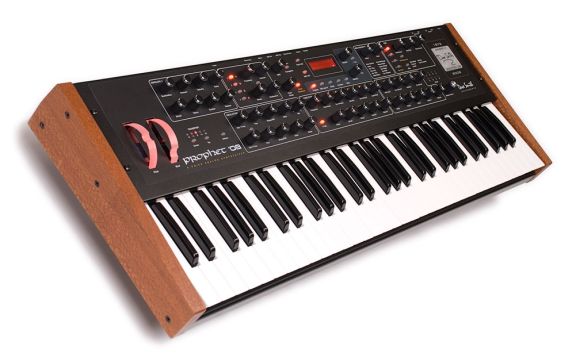
There are few names who have had so profound an impact on music technology as Dave Smith. Three decades after the introduction of the Prophet-5, and nearly 25 years after the first MIDI product shipped, his new creations remain some of the most sought-after musical instruments available. The new Prophet ’08 is capable of producing just as much excitement as some of those earlier landmarks. That’s why we’re pleased to offer this entirely non-exclusive interview with —
Yes, that’s right. I said “non exclusive.” The word “exclusive” gets thrown around a lot, usually meaning something that really isn’t terribly exclusive at all. But in this case, we’re pleased to collaborate with our friends at the leading Spanish-language music technology site, Hispasonic.com. I worked with Xabi to brainstorm some ideas to talk about, and Xabi conducted the interview. For those of you for whom Spanish is your native language, definitely don’t miss the version on Hispasonic:
Dave Smith, el profeta de los sintes
Here in English, Dave talks about the genesis of the new Prophet-8, and reflects on synthesizers and musical instruments in general. I’m not sure I’m going to agree that only hardware synths are “real instruments” and software synths are best for beginners, until they get “serious.” (I would absolutely agree that’s the case with emulation, and that software synths should go their own way, both of which seem to be his main points. Hopefully we’ll get to do an in-person interview soon.) But I will agree that Dave truly creates real instruments, and his unique angle on design should be a challenge to hardware and software developers alike. And not even the most die-hard software lover could argue with the musical prowess of the Prophets — and their creator.
Hispasonic: 30 years after the almighty Prophet-5, here is the all-new Prophet-08. As a synth pioneer, please tell us about your feelings around the development of synth history over these past 30 years. How have synthesizers have changed our world?
DS: They have certainly changed all types of music significantly. Likely the most important change was putting more sound power into an individual’s control; home studios with synths can produce a very wide range of music, often from a single person.
Has the “roof” of synth technology been reached? Is there room to innovate further? Or are we doing circles around old concepts? Do you think that everything has been invented in the synthesizer world?
DS: Certainly the innovation steps are smaller every year. With emulative synthesis, the limit is usually in the controller; in other words, to really control a great synthesized violin sound, you need a controller with something to control a bowing movement, and something like a string. It gets to the point where you may as well play a real violin! Then again, basic subtractive synthesis has so far passed the test of time for over 40 years, so old concepts still sound good and work well.
Think about all the major innovations in the synthesizer history. Which is the one that makes you think “I would have loved to invent that one!”
DS: Hard to say; I tend to concentrate on my own ideas, and I am not very good at keeping track of the other instruments on the market.
You say: “Prophet ’08 is the product of evolution, not nostalgia”. What are the technological highlights in this new synth? Which are the aspects of the Prophet 08 that you like the most? How does it improve over the classic Sequential Circuits synths?
DS: I started the design with Curtis synthesis ICs [integrated circuits] to capture the classic sounds. But the control aspects go way beyond the original. For example, the Prophet-5 had one LFO; the Prophet 08 has 32!

Did you find any obstacles during the Prophet 08 design and manufacturing process? Any anecdotes to tell about this?
DS: Originally I was not thinking of making a “Prophet”; it was just going to be a fairly-priced, 8-voice analog synth. Once I started playing it, as the design came together, the sounds were more powerful that the original prophets, but still retained the classic sound. So it was only then that I decided to call it a Prophet.
You have had big success as a hardware synth developer, but also in the world of software synths, with Seer Systems’ Reality, the first fully professional software synthesizer. What’s your opinion of the present software synths? How have they evolved since Reality? How do you imagine the future of software synths?
DS: Software synths are nice because they are cheap, and usually sound good. I think it’s silly to just keep copying vintage analog synths, though. They should be concentrating on new synthesis and instruments, rather than trying to copy the real thing.
Are software and hardware synths opposites? Will software synths “kill the hardware synth star”? Do we have to choose between analog hardware synths, virtual analog hardware synths and software synths, or do they have their own place in a studio/performance?
DS: Again, it’s often simply a price issue. I think it’s great that many new and younger musicians can start with free or cheap soft synths and learn the basics. Then, once they get more serious about synthesis, they can then go out and get a real instrument. Even though I have been using computers since the 60s, I still do not like working with a PC or a Mac to play an instrument. Meanwhile, I hear from more and more players who are tired of soft synths and computers, and want a real instrument. Then they hear an Evolver or Prophet-08 and immediately understand the difference.

Which is your favorite synth -not designed by you-, hardware and software?
DS: No opinions here, sorry to say.
Have you any plans about integrating your hardware synths with DAWs, like Virus TI? What do you think about that integration concept?
DS: Not at the moment; as a designer, I love to work with my own hardware. I hate working with PCs and Macs and their operating systems. It’s no fun! You spend all your time dealing with changing systems, crashes, incompatibilities, and not on the instrument itself.
Have you any plans of releasing new software synths?
DS: I should never say never, but it’s very very unlikely!
And finally, please drink some wine and relax before answering this one: could you advance any data about the new Boomchik drum box? 😉
DS: No specifics; hope to have a prototype at NAMM in January, and ship in the Spring.
CDM: Dave, you were of course instrumental in making MIDI happen. But the core implementation of MIDI on musical instruments (leaving aside the various extensions to MIDI) remains largely unchanged. Is there any hope for us to see the kind of improvement we saw with the original unveiling of MIDI any time in the near future? Are there changes you would like to see?
DS: It would be very difficult to update MIDI; when we did it originally, there were only five companies involved, and most of the work was done by two (Sequential and Roland). Now, MIDI is used everywhere, not just for synthesizers. There are so many companies (synths, keyboards, PCs, cell phones, lighting, portable keyboards, effects, recorders, etc) with MIDI installed, that it would be nearly impossible. What would it be? Would it include audio? If so, what speed, how many tracks, etc? Then, what about video? As you can see, it could very well get out of hand.
Ed. note: one possibility of what it could be, answering some of these questions, is in the evolving interactive music spec iXMF, in turn extending XMF, a format bringing together sampled audio instruments with MIDI note data. We’ll be looking at iXMF later, but I’ll hasten to add it’s really a means of describing music, not necessarily control data — like MIDI as sent from a keyboard. So, as Dave says, there’s really a lot that’s unanswered and tricky to change. I bring this up as I expect we’ll be examining some of these issues over the coming months. -PK
CDM: What’s your own music-making process like at this point? What do you use, and how?
DS: I rarely use my old instruments; I much prefer a Poly Evolver or P08. Exception might be the VS; nothing sounds like a VS, though it is somewhat limited in sound possibilities. But, after working on synths all day, I prefer to pick up a guitar; it’s a nice change of pace, and it helps remind me of the personality of real instruments, how they dont need to change and get updated every year, and how good analog instruments sound.